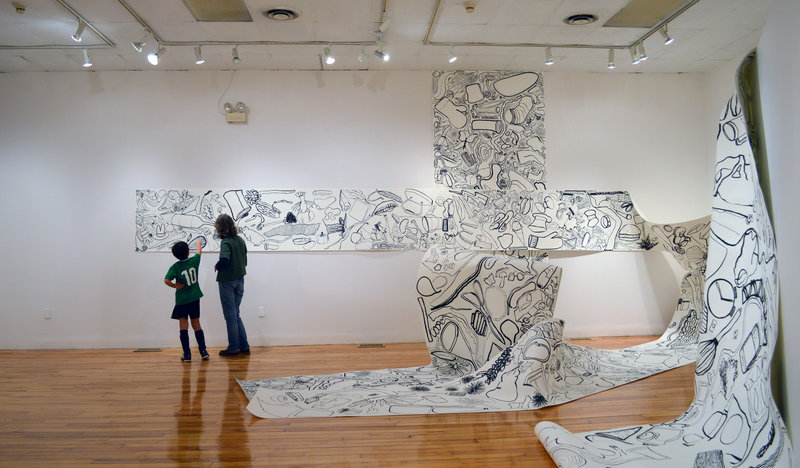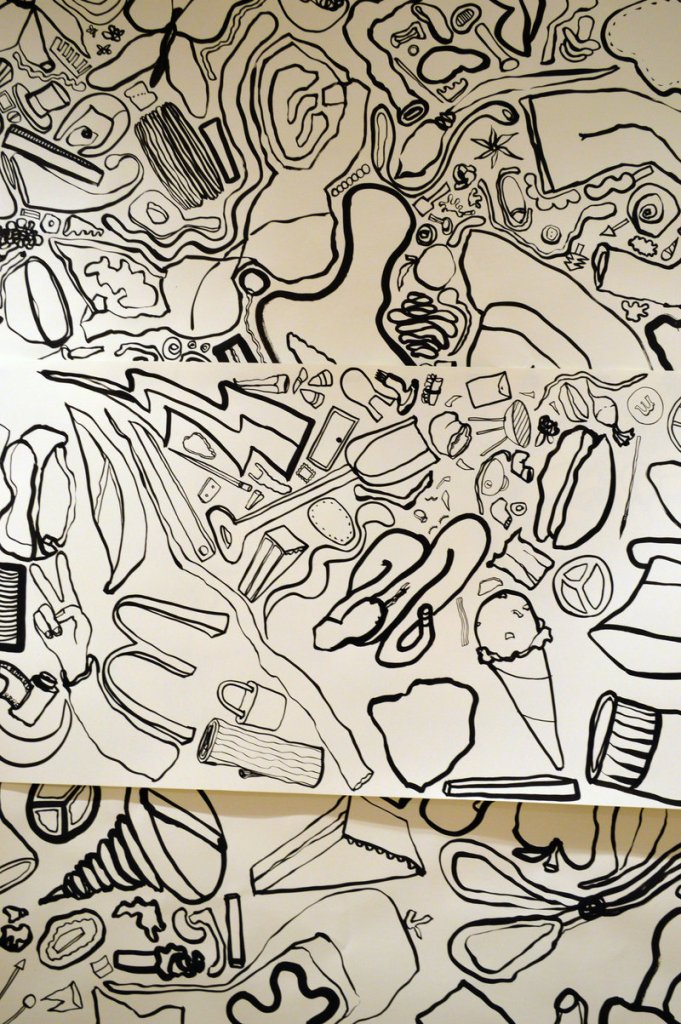How could anyone underestimate a show titled “Everything”?
Yet it’s practically impossible not to underestimate Astrid Bowlby’s drawing installation on view and ever-growing in the University of Southern Maine Gorham art gallery.
It’s an installation of simplified black ink drawings of easily identifiable things. Bowlby has taken requests from the public via written suggestions dropped in a fish bowl at the entrance to the gallery space. The drawings cover the giant rolls of fine paper without regard for scale or orientation, and only white margins to separate them.
Completely free of any fuss or affect, the images adhere to a clearly legible contemporary cartoon style. However, because we grew up with this style of kid-oriented drawing — from the still-beloved Sunday comic section to Saturday morning cartoons, comics and illustrated children’s books — it’s difficult for us to see that this style is culturally specific. It is so endemic to our culture that we see it as simple, or even natural.
But it’s not.
In the gallery, you will find the artist trying to keep up with the requests. Since the start of the show (“start” — as opposed to an “opening”), Bowlby has drawn thousands of objects: Apples, animals, bicycles, carrots, fishing hooks, toilet paper rolls, clocks, kites, squid, squash, laptops, rulers and rolling pins. Anything we could put into words, Bowlby has drawn.
Cool things happen. A line across it turns a beet into a turnip — and makes me see purple. A black-and-white Curious George-style hat blossoms bright yellow. A swimming squid suddenly sea-soaks the surrounding stuff.
Bowlby’s giant rolls of paper are mounted on the walls; they crisscross and flow down and over objects into space. If you look to this as sculpture or installation, you might be disappointed by its lack of finish. But if you see this as an active studio space, the empty parts stand as a challenge rather than as a backdrop to be dissolved into invisibility.
It is key to the show that the blank paper and walls glisten with potential: “Everything” isn’t what Bowlby actually draws, but it’s what she could draw. In other words, everything is in range of the show.
The reason “Everything” passes from simple drawings of discreet objects into the realm of conceptual art is because it is fundamentally a philosophical inquiry about how ideas continually travel from language to visual art and back again.
The true insight of “Everything,” however, is that it’s not a simple potential-to-kinetic equation, but the endless process of culture that never ceases to progressively produce more meaning and go to new places.
It’s the kind of thinking behind, for example, Andre Gide’s 1925 novel “The Counterfeiters,” Andy Warhol’s repeated images of celebrities, Picasso and Braque’s cubist paintings, and Jean Baudrillard’s 1981 philosophical treatise “Simulacra and Simulation” that discusses not only copies of things (simulacra) but imitations of real-world processes (simulation).
When I first saw “Everything,” I thought of Diderot’s “Encyclopedie” — the enlightenment engine he started in 1751. The idea was that by compiling all knowledge, future generations “becoming better instructed, will at the same time become more virtuous and happy.”
In other words, it was moral philosophy with a historical trajectory whose key lied — as with Bowlby’s “Everything” — in its potential.
This is where Bowlby veers away from typical visual art. She is on site, taking requests directly from her audience. This makes all the difference.
I went twice with my young boys. We got to see the show grow. Bowlby showed them where she drew some of their (predictably weird) first-visit requests. Then the boys made more (and weirder) requests. Bowlby was terrific with them, and they absolutely loved it.
The big difference is that the artist is part of this show. As a critic, I usually prefer not to talk to (or about) the artists, because I am writing for the experience of the typical viewer — and typical viewers don’t have curatorial input or personal conversations with the artist while she works.
But this time, everyone can.
This is a here-and-now show, and deeply American. After all, this is the land of infinite possibilities where anything goes — and sometimes, as Bowlby reminds us, even everything is possible.
Freelance writer Daniel Kany is an art historian who lives in Cumberland. He can be contacted at:
dankany@gmail.com
Send questions/comments to the editors.




Success. Please wait for the page to reload. If the page does not reload within 5 seconds, please refresh the page.
Enter your email and password to access comments.
Hi, to comment on stories you must . This profile is in addition to your subscription and website login.
Already have a commenting profile? .
Invalid username/password.
Please check your email to confirm and complete your registration.
Only subscribers are eligible to post comments. Please subscribe or login first for digital access. Here’s why.
Use the form below to reset your password. When you've submitted your account email, we will send an email with a reset code.